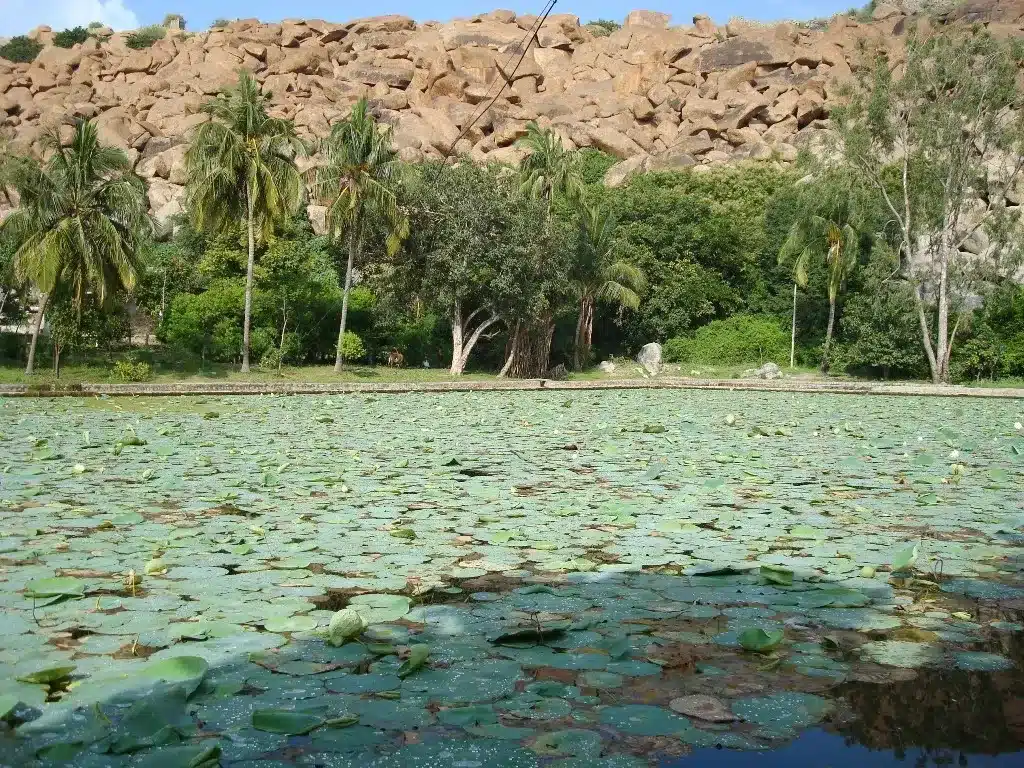About Pampa Lake:
- Pamba Lake/Pampa Sarovar is situated in Koppal district near Hampi in Karnataka.
- It is located to the south of the Tungabhadra River.
- It is one of the five sacred lakes known as Panch-Sarovar in Hindu mythology, which are namely, Man Sarovar, Bindu Sarovar, Narayan Sarovar, Pampa Sarovar, and Pushkar Sarovar.
- In Hindu mythology, Pampa Sarovar is regarded as the place where Pampa, a form of Shiva’s consort Parvati, performed penance to show her devotion to Shiva.
- It is also one of the Sarovars that finds a mention in the Hindu epic, Ramayana as the place where Shabhari, a devotee of Lord Rama, waited for the arrival of Rama.
- The lake is surrounded by hills and temples and filled with lotuses.
Key Facts about Tungabhadra River:
- It is a major river in the south Indian peninsula.
- It is a major tributary of the Krishna River.
- Origin:
- It is formed by the union of two rivers, Tunga and Bhadra, hence the name.
- Both the Tunga and Bhadra Rivers originate on the eastern slopes of the Western Ghats.
- The two rivers merge at Koodli in the Shimoga district of Karnataka, giving birth to the Tungabhadra River.
- Course:
- It flows in a more or less northwest direction before joining the Krishna River at Sangamaleshwaram in Andhra Pradesh.
- The Krishna River finally ends in the Bay of Bengal.
- The river has a total length of 531 km and a catchment area of 28,000 sq. km.
- It flows through the states of Karnataka and Andhra Pradesh.
- It is influenced chiefly by the South-West monsoon.
- Major Tributaries: Varada River and Hagari (Vedathy) River.
- The river has several dams and reservoirs built on it, including the Tunga Anicut Dam, the Bhadra Dam, the Hemavathy Dam, and the Tungabhadra Dam.
Q1: Which are the main tributaries of Krishna River?
The principal tributaries joining Krishna are the Ghataprabha, the Malaprabha, the Bhima, the Tungabhadra and the Musi.
Last updated on December, 2025
→ Check out the latest UPSC Syllabus 2026 here.
→ Join Vajiram & Ravi’s Interview Guidance Programme for expert help to crack your final UPSC stage.
→ UPSC Mains Result 2025 is now out.
→ UPSC Notification 2026 is scheduled to be released on January 14, 2026.
→ UPSC Calendar 2026 is released on 15th May, 2025.
→ The UPSC Vacancy 2025 were released 1129, out of which 979 were for UPSC CSE and remaining 150 are for UPSC IFoS.
→ UPSC Prelims 2026 will be conducted on 24th May, 2026 & UPSC Mains 2026 will be conducted on 21st August 2026.
→ The UPSC Selection Process is of 3 stages-Prelims, Mains and Interview.
→ UPSC Result 2024 is released with latest UPSC Marksheet 2024. Check Now!
→ UPSC Prelims Result 2025 is out now for the CSE held on 25 May 2025.
→ UPSC Toppers List 2024 is released now. Shakti Dubey is UPSC AIR 1 2024 Topper.
→ UPSC Prelims Question Paper 2025 and Unofficial Prelims Answer Key 2025 are available now.
→ UPSC Mains Question Paper 2025 is out for Essay, GS 1, 2, 3 & GS 4.
→ UPSC Mains Indian Language Question Paper 2025 is now out.
→ UPSC Mains Optional Question Paper 2025 is now out.
→ Also check Best IAS Coaching in Delhi

















